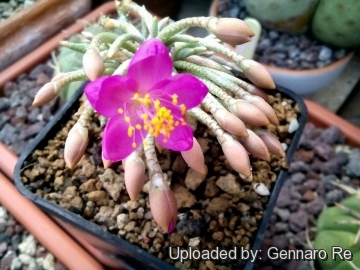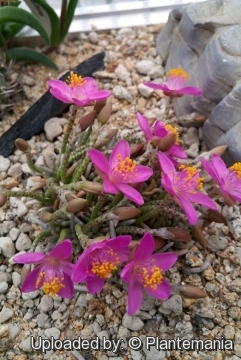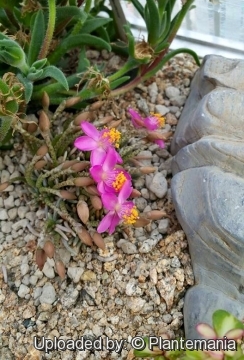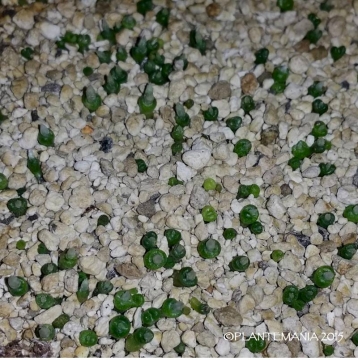Accepted Scientific Name: Avonia quinaria (E.Mey. ex Fenzl) G.D.Rowley
Bradleya 12(prepr.): 111 1994

Anacampseros quinaria (Avonia quinaria) Photo by: Sándor Horváth
Origin and Habitat: South-eastern Namibia to Bushmanland and north-eastern Namaqualand South Africa. Type locality near Lislap, Boshmannskarroo.
Habitat: Nama Karoo, Succulent Karoo. Avonia quinariaSN|25184]]SN|25184]] grows in dry flats and gentle and slopes on quartzite and red sand , under severe conditions - hard soil, dazzling exposure, little rain, in dwarf shrub and succulent steppe with other dwarf succulents like Adromischus nanusSN|15199]]SN|15199]] and conophytum ssp.. It is widespread and not in danger of extinction.
Synonyms:
See all synonyms of Avonia quinaria
back
Accepted name in llifle Database:Avonia quinaria (E.Mey. ex Fenzl) G.D.RowleyBradleya 12(prepr.): 111 1994Synonymy: 2
Accepted name in llifle Database:Avonia quinaria subs. alstonii (Schönland) G.D.RowleyBradleya 12(prepr.): 111 1994Synonymy: 3
back
Common Names include:
CHINESE (中文): 韧锦
Description: Avonia quinariaSN|25184]]SN|25184]] is a dwarf perennial caudiciform succulent usually deep-seated, that flush with soil surface in habitat.
Caudex: Turnip-shaped, fleshy to somewhat woody, flattened above, to 2,5-5 cm in diameter, (often pulled down into the ground in time of drought) with, a spherical crown of thin branches up to 2,5 cm above ground. However some exceptional plants found in nature exceed 10 cm in diameter and could be several centuries years old.
Branches: Sub-terminal, numerous, sterile and flower-bearing, undivided, very short, 2 mm thick.
Stipules: Spirally arranged, and closely 5- overlapping imbricated, broad-ovate to triangular, entire, not hairy at the base, parchment-like, silvery with brownish spots.
Leaves: Very minute semi-orbicular flattish, completely hidden by the stipules.
stipules scarious, white, spirally involucral leaves larger, sphacelate at top; flowers exserted.
Sterile stems: 2-4 mm long.
Fertile stems: 8-12 mm long, terete, silver-coloured.
Stipules: 1 mm, the involucre 2 mm long.
Flowers: Carmine red or pink, 1,2-1,5 cm in diameter about 6 mm long. Sepals ovate, obtuse. 2–4 times longer than the involucre. Self-fertile, they can produce seeds even if you have only one plant.
Subspecies, varieties, forms and cultivars of plants belonging to the Avonia quinaria group
 Avonia quinaria (E.Mey. ex Fenzl) G.D.Rowley: (subsp. quinaria) Flower purple, 1,2-1,5 cm in diameter, leaves in a spiral. Distribution: South-eastern Namibia to Bushmanland and north-eastern Namaqualand.
Avonia quinaria (E.Mey. ex Fenzl) G.D.Rowley: (subsp. quinaria) Flower purple, 1,2-1,5 cm in diameter, leaves in a spiral. Distribution: South-eastern Namibia to Bushmanland and north-eastern Namaqualand. Avonia quinaria subs. alstonii (Schönland) G.D.Rowley: Flowers white up to 3 cm in diameter, leaves in 5 rows on the stem. Distribution: northern Namaqualand, Cape Province, South Africa.
Avonia quinaria subs. alstonii (Schönland) G.D.Rowley: Flowers white up to 3 cm in diameter, leaves in 5 rows on the stem. Distribution: northern Namaqualand, Cape Province, South Africa.
Bibliography: Major references and further lectures
1) William Henry Harvey, O. W. Sonder “Flora Capensis: Being a Systematic Description of the Plants of the Cape Colony, Caffraria, and Port Natal” Volume 2, 1862
2) Urs Eggli “Illustrated Handbook of Succulent Plants: Dicotyledons” Springer, 2002
3) Ben-Erik Van Wyk, Nigel Gericke “People's plants: a guide to useful plants of Southern Africa” Briza, 2000
4) Hermann Jacobsen “A handbook of succulent plants: descriptions, synonyms, and cultural details for succulents other than Cactaceae” Volume 1: 222 (1960) Blandford Press
5) Stuart Max Walters “The European Garden Flora: Casuarinaceae to Aristolochiaceae” Cambridge University Press, 1989
6) Steven A. Hammer “Dumpling and his wife: new views of the genus Conophytum” EAE Creative Colour Ltd., 2002
7) Gerbaulet, M. "Die Gattung Anacampseros L. (Portulacaceae)." I. Untersuchungen zur Systematik. Botanische Jahrbücher für Systematik 113(4):477-564.1992
8) Hilton-Taylor, C. "Red data list of southern African plants". Strelitzia 4. South African National Botanical Institute, Pretoria. 1996
9) Raimondo, D., von Staden, L., Foden, W., Victor, J.E., Helme, N.A., Turner, R.C., Kamundi, D.A. and Manyama, P.A. "Red List of South African Plants". Strelitzia 25. South African National Biodiversity Institute, Pretoria. 2009.
10)Snijman, D.A. "Plants of the Greater Cape Floristic Region 2: The extra Cape flora." Strelitzia 30. South African National Biodiversity Institute, Pretoria.
2013.
11) von Staden, L. 2015. "Anacampseros quinaria" E.Mey. ex Fenzl. National Assessment: Red List of South African Plants version 2015.1. Accessed on 2016/01/05
 Anacampseros quinaria (Avonia quinaria) Photo by: Valentino Vallicelli
Anacampseros quinaria (Avonia quinaria) Photo by: Valentino Vallicelli Anacampseros quinaria (Avonia quinaria) Photo by: Gennaro Re
Anacampseros quinaria (Avonia quinaria) Photo by: Gennaro Re Anacampseros quinaria (Avonia quinaria) Photo by: © Plantemania
Anacampseros quinaria (Avonia quinaria) Photo by: © Plantemania Anacampseros quinaria (Avonia quinaria) Photo by: © Plantemania
Anacampseros quinaria (Avonia quinaria) Photo by: © Plantemania Avonia quinaria. Seedlings. (Avonia quinaria) Photo by: © Plantemania
Avonia quinaria. Seedlings. (Avonia quinaria) Photo by: © PlantemaniaSend a photo of this plant.The gallery now contains thousands of pictures, however it is possible to do even more. We are, of course, seeking photos of species not yet shown in the gallery but not only that, we are also looking for better pictures than those already present.
Read More... Cultivation and Propagation: Although regarded as a choice and difficult plant, in cultivation it is relatively easy. It is a particular favourite of caudiciform plant enthusiasts.
Growth rate: Plants grow very slowly and caudex take many years to enlarge. Clustering in cultivation, if grown correctly, it will reward the grower with generous displays of tiny flowers.
Caudex exposure: The remarkable tuberous rootstock (caudex) is often raised 1-3 cm above the soil line so that this can be seen and more readily appreciated. For best results the tuber must be exposed only when plans become mature enough, usually after several years (8-12 or more years) of underground growth, as the exposed caudex will no longer increase in size once it has been lifted above the soil line.
Potting medium: Since roots are quite shallow, use a cactus mix or add extra perlite or pumice to regular soil potting soil. A gritty, very free-draining compost is suitable, and clay pots help the plants to dry out between watering. For best results, use a shallow pot, and only use the smallest diameter pot that will accommodate the plant.
Fertilization: Need a perfect fertilizer diet in summer. Use preferably a cacti and succulents fertilizer with high potassium content including all micro nutrients and trace elements or slow release fertilizer.
Watering Needs: Water normally in the growing season from March to October. No water should ever be allowed to stand around the roots. Keep almost completely dry in winter. The swollen caudex makes it very tolerant of under watering.
Hardiness: It is quite frost resistant if kept dry, hardy as low as -5° C. It can be grown outdoors in the summer months to benefit from direct exposure to light, and especially exposure to high summer temperatures. Recommended Temperature Zone: USDA 10-12.
Sun Exposure: This plant has an excellent heat tolerance, and need full sun to light shade exposures. High levels of light are needed to flower and for good plant development.
Rot: Rot it is only a minor problem with Avonia if the plants are watered and “aired” correctly. If they are not, fungicides won't help all that much. The plant turns immediately to mush when over watered, or watered out of season. Care must be given in watering, keeping them warm and wet while growing, and cooler and dry when dormant.
Traditional uses: The dried and pulverized roots and stems were once used as yeast for backing bread and also to brew mead (Honey beer). The fresh corms were also used to treat diabetes they was crushed, boiled and ½ of a cup of decoction taken orally.
Reproduction: The seed will loose viability in storage, and may not be viable the following year, so the seed should be planted as soon after harvesting as possible. Germination usually occurs within about a week or two. Seed germinate at 15-21 °C.















